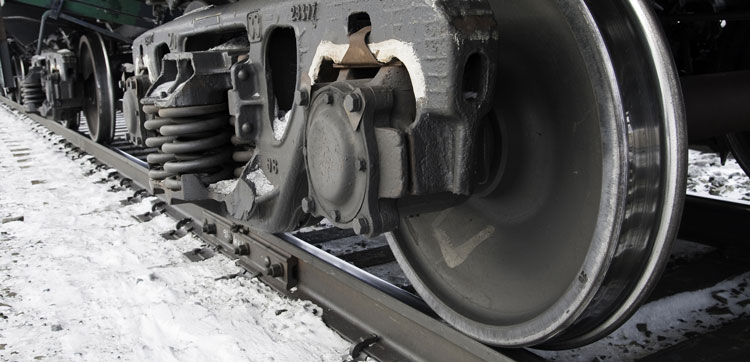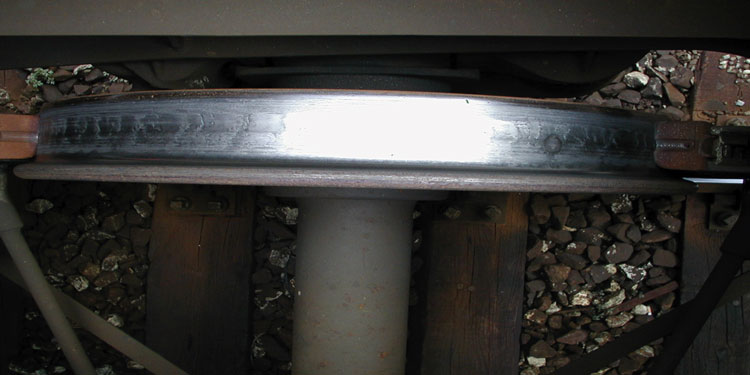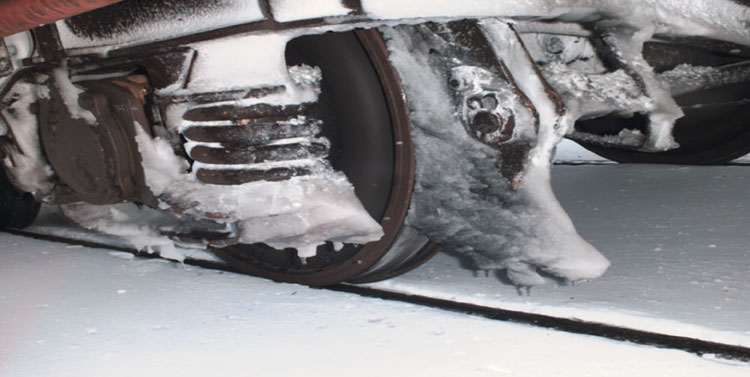UIC works to reduce train noise with composite brake shoes
Posted: 3 April 2007 | Hans Paukert | No comments yet
The reduction and possible elimination of noise became an issue that is steadily gaining importance on railways. After ‘TSI noise’ came into force on 23 June 2006, all new-built rolling stock has to comply with it. One of the main sources of railway noise is the rolling sound of the wheel on the rail. The rougher and the less round the wheel surface – the greater the noise emitted.


Cast-iron brake shoes, still widely used on freight wagons, make the wheel surface much rougher than a similar product made from composite material due to the fusing of minute metal particles into the tread surface during braking (Figure 1).
Reducing noise from train wheels
Replacing cast-iron shoes with a synthetic product can therefore substantially reduce wagon noise emissions, for example by about 10dB for a 100km/h freight train.
However, a number of technical problems must first be solved:
- The substitute product must ensure that the friction coefficient required is capable that the specified stopping distance is guaranteed in all weather conditions
- In a train of mixed configuration of wagons equipped with cast iron brake shoes and composite brake shoes, braking must not be allowed to produce non-permissible longitudinal forces or other effects requiring special measures to be taken by the locomotive driver
- Approximately 25 to 30% of the friction heat produced during braking is currently dissipated by the cast-iron brake shoe; the rest by the wheel. Composites are much less efficient as heat conductors than metals, resulting in an increase in the amount of energy to be dissipated by the wheel. The wheels must therefore be able to deal with this greater proportion of energy
- Overall, the substitute product must not be more expensive than cast-iron brake shoes, so as not to aggravate rail’s already-difficult competitive position


Figure 1: Train wheel made from composite material
Nevertheless, it has to be admitted that cast iron brake shoes offer a number of advantages, including:
- Their friction coefficient is almost independent from atmospheric conditions
- The material properties are independent from the Manufacturer
- They guarantee a suitable dissipation of heat generated during braking
- Small flats are grinded-down during subsequent brake applications
- Due to the constant roughening of the wheel surface a consistent adhesion level is maintained
The main disadvantage of cast iron is the double dependency of its friction coefficient versus speed and application force.
Consequently, two approaches were determined to replace cast-iron brake shoes by a substitute of composite or sintered material:
- ‘K-shoes’ with a higher but steady friction coefficient. They were to be applied for new to-build or refurbished rolling stock
- ‘LL-shoe’s with an almost identical friction coefficient as cast iron, intended to replace these without any further action required
Testing new train braking materials
Dynamometer tests are used for a pre-selection of materials, followed by slip-brake tests to determine the braking performance. To prove the capability of the new system to comply with operational demands even under extreme conditions braking tests on alpine slopes were conducted. To assure their braking capability under winter conditions they were subject to line tests in Sweden and in the climatic chamber of RTA (Figure 2).


Figure 2: Train braking systems tested in the snow of Sweden
A winter test programme on the dynamometer is about to be finalized within the next few months to replace the costly method of line tests. Unfortunately, experiences from North American Railroads – where composite brake shoes are used since a long time – were not transferable as their operating conditions are completely different from those in Europe:
- Dedicated freight lines
- Lower braking performance (~~30% against 65% of braked weight percentage for a laden wagon)
- Longer signalling distances
- Descending long gradients at very low speeds (27 km/h)
Three products with a high friction coefficient (K-blocks) were finally identified as being capable to respect all above mentioned requirements. It is now necessary to prove their sustainability in service and to demonstrate that their LCC are not superior to those of cast iron. To gain experience on brake block and wheel wear several freight vehicles in revenue service were equipped with composite brake blocks. Regularly parameters such as wheel surface, wheel diameter, remaining stresses in the wheel rim, together with block wear are controlled, thus being the only method to gain experience on LCC. Positive results led to the equipment of meanwhile approximately 8500 wagons with K-blocks in revenue service, but the economic success of K-shoes depends on their interchange ability between different products, which is not yet the case for all certified products. Operating needs led to new additional requirements for composite brake blocks:
- Deposits of worn material, with is electrical isolating for composite brake blocks, must not lead to a malfunction of track circuits used for signalling systems. To ensure this specification a rig test was developed
- Brakes not completely loose (remaining pressure in brake cylinder) after complete refill of the main brake pipe must not entail an unacceptable increase of the wheel temperature. Cast is melting in such case preventing the wheel from excessive heat. In additional dynamometer test was created to guarantee that the substitute materials comply with that requirement
- Handbrakes are still widely used to secure wagons at standstill and for braking at marshalling yards as well as redundancy to secure a train in case of a locomotive failure on a gradient. TSI requires a safe immobilisation of the laden wagon in a gradient of 40 per thousand. Wagons equipped with cast iron brake shoes fulfil this requirement. Due to the lower static friction coefficient of composite materials additional technical measures are necessary (e.g. increase of amplification of handbrake lever) to comply with this specification.
Ongoing commitment to efficient, low-noise wheels and brakes
The UIC braking experts committee is continuously working to overcome these obstacles, as well as to translate potential advantages of K-blocks (the higher friction coefficient would allow a considerable mass reduction of the brake rigging) into new technical solutions.
As mentioned above, ‘TSI Noise’ limits noise emission for freight wagons to a threshold that is only achievable if a vehicle is equipped with composite brake blocks or disc brakes. But ’TSI noise’ is only applicable for new rolling stock or vehicles subject to a major refurbishment, existing vehicles may remain in use until the end of their useful life.
A considerable reduction of the noise emission is only achievable if the percentage of cast-iron braked vehicles in a train drops below 30%. Due to the longevity of the life of railway wagons (25-35 years) a mid-term (within the next 7-10 years) reduction in noise emission will only be feasible, if a replacement product can be found with exactly the same friction behaviour as cast iron: the LL-brake block. That would allow replacing cast iron brake shoes in a great number of existing freight vehicles without any additional modifications. During the development of LL-blocks a great number of drawbacks were encountered.
- Identical friction behaviour to cast iron over the whole speed and load range is very difficult to achieve by a substitute
- So far only sintered products were able to comply with the operational requirements on long alpine gradients
- Only products which are economically not acceptable are able to comply with the requirements according the ‘brake failure’ dynamometer programme.
Although the technical development of these so-called LL brake blocks is fairly advanced and finally three types of LL blocks obtained a provisional UIC approval for international traffic, a number of open questions- see above- remain unsolved for the moment. As the exchange of cast iron blocks against LL-blocks will happen on a purely voluntary basis the LCC issue costs is here even more important than for K-blocks in new vehicles. Beside a technically developed functional solution for LL-blocks only a serious guarantee that switching from cast iron to LL-blocks will not entail a LCC penalty can convince wagon owners to convert their fleet.
- A series of cracked wheels at the end of the 80s led to the ban of composite brake blocks in new freight wagons which stopped the development of composite brake shoes until the end of the nineties.
About the author




